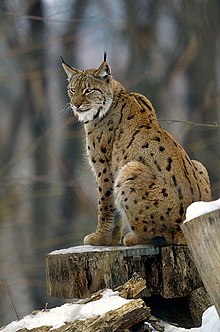Eurasian lynx
| Eurasian lynx | |
|---|---|
 |
|
| Scientific classification | |
| Kingdom: | Animalia |
| Phylum: | Chordata |
| Class: | Mammalia |
| Order: | Carnivora |
| Family: | Felidae |
| Genus: | Lynx |
| Species: | L. lynx |
| Binomial name | |
|
Lynx lynx (Linnaeus, 1758) |
|
 |
|
| Eurasian lynx range | |
| Synonyms | |
The Eurasian lynx (Lynx lynx) is a medium-sized cat native to Siberia, Central, East, and Southern Asia, North, Central and Eastern Europe. It has been listed as Least Concern on the IUCN Red List since 2008 as it is widely distributed, and most populations are considered stable. Eurasian lynx have been re-introduced to several forested mountainous areas in Central and Southeastern Europe; these re-introduced subpopulations are small, less than 200 animals.
Precise classification of the subspecies of the Eurasian lynx is still the subject of debate, but based on recent interpretation, the list includes:
The Eurasian lynx is the largest lynx species, ranging in length from 80 to 130 cm (31 to 51 in) and standing 60–75 cm (24–30 in) at the shoulder. The tail measures 11 to 24.5 cm (4.3 to 9.6 in) in length. Males usually weigh from 18 to 30 kg (40 to 66 lb) and females weigh 8 to 21 kg (18 to 46 lb). Male lynxes from Siberia, where the species reaches the largest body size, can weigh up to 38 kg (84 lb) or reportedly even 45 kg (99 lb). It has powerful, relatively long legs, with large webbed and furred paws that act like snowshoes. It also possesses a short "bobbed" tail with an all-black tip, black tufts of hair on its ears, and a long grey-and-white ruff.
During the summer, the Eurasian lynx has a relatively short, reddish or brown coat, which tends to be more brightly coloured in animals living at the southern end of its range. In winter, however, this is replaced by a much thicker coat of silky fur that varies from silver-grey to greyish brown. The underparts of the animal, including the neck and chin, are white at all times of the year. The fur is almost always marked with black spots, although the number and pattern of these are highly variable. Some animals also possess dark brown stripes on the forehead and back. Although spots tend to be more numerous in animals from southern populations, Eurasian lynx with heavily spotted fur may exist close to others with plain fur.
...
Wikipedia

